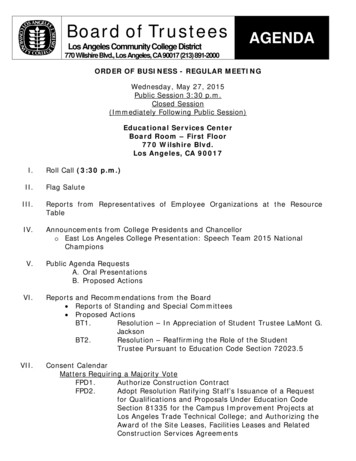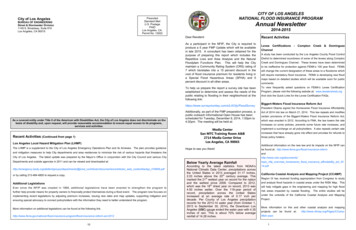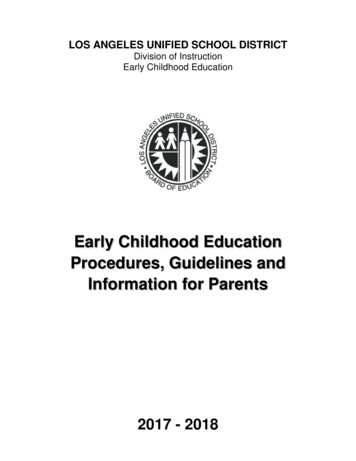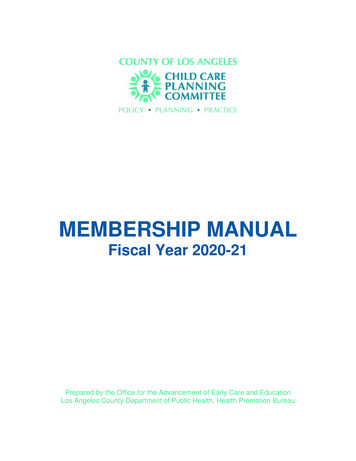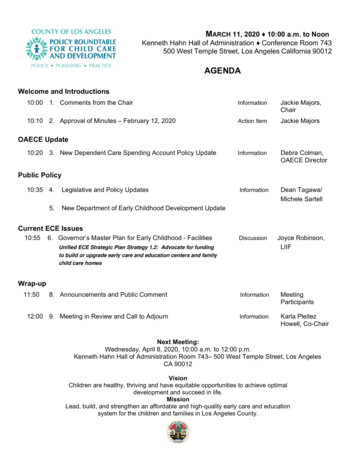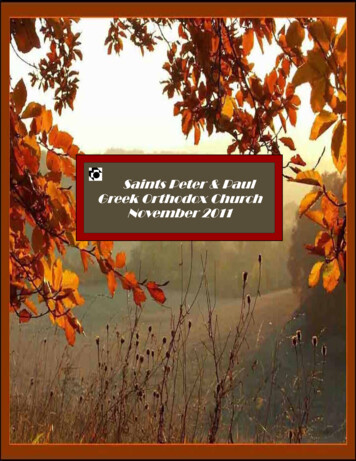
Transcription
November 2011 Master.qxp10/14/113:32 PMPage c1Semiannual Guide to Expert WitnessesNovember 2011 / 4PLUSEARN MCLE CREDITArbitrator DisclosureRequirementspage 29CauseMarketingpage 12CopyrightTerminationGappage 36ReceivershipFeespage 16Smart PhoneSecuritypage 69PrenuptialPracticeLos Angeles attorneyFranklin R. Garfield advisespractitioners on how to avoidmalpractice claims arisingfrom prenuptial agreementspage 22
November 2011 Master.qxp10/14/113:32 PMPage c2
November 2011 Master.qxp10/14/113:38 PMPage 1
November 2011 Master.qxp10/14/113:38 PMPage 2INSURING LAW FIRMS ONE POLICY AT A TIMEENDORSED INSURANCE BROKERWWW.AHERNINSURANCE.COMT 800.282.9786LICENSE #0C04825
November 2011 Master.qxp10/14/113:38 PMPage 3F E AT U R E S22 Prenuptial PracticeBY FRANKLIN R. GARFIELDAttorneys may avoid malpractice claims or being summoned as witnesses todivorce hearings by memorializing all the terms of their prenuptial representation29 Full DisclosuresBY RICHARD R. MAINLANDCourts are increasingly willing to hold parties in an arbitration to a duty toinvestigate potential arbitrators’ bias before their selectionPlus: Earn MCLE credit. MCLE Test No. 208 appears on page 31.36 The Gap YearsBY JAKE SHAFERCourts will soon decide whether authors may terminate copyright assignments onworks they created after January 1, 1978, under contracts signed before that date42 Special SectionSemiannual Guide to Expert WitnessesLos Angeles LawyerD E PA RT M E N T Sthe magazine ofthe Los Angeles CountyBar AssociationNovember 201110 Barristers TipsShaping the role of ACOs in thegovernment’s new healthcare programBY SAM WALDVolume 34, No. 8COVER PHOTO: TOM KELLER12 Tax TipsLegal and tax issues in cause marketinginitiativesBY KENT E. SETON, JESSICA SHOFLER, ANDCOURTNEY WAGGONER16 Practice TipsCompensating receivers and theirprofessionals in bankruptcy courtLOS ANGELES LAWYER (ISSN 0162-2900) is published monthly,except for a combined issue in July/August, by the Los AngelesCounty Bar Association, 1055 West 7th Street, Suite 2700,Los Angeles, CA 90017 (213) 896-6503. Periodicals postage paidat Los Angeles, CA and additional mailing offices. Annual subscription price of 14 included in the Association membershipdues. Nonmember subscriptions: 28 annually; single copyprice: 4 plus handling. Address changes must be submittedsix weeks in advance of next issue date. POSTMASTER: AddressService Requested. Send address changes to Los AngelesLawyer, P. O. Box 55020, Los Angeles CA 90055.BY ASHLEY M. MCDOW72 LACB Foundation2010-2011 Fund Drive Results76 Closing ArgumentThe exaggerated demise of the billablehourBY KEN SWENSON71 Classifieds74 Index to Advertisers75 CLE Preview11.1169 Computer CounselorCell phone security for attorneysBY GORDON ENG
November 2011 Master.qxp10/14/113:39 PMPage 4Judge Michael D. Marcus (Ret.)Mediator Arbitrator Discovery RefereeDaily Journal Top Neutral 2007, 2009 & 2010Super Lawyer, Dispute Resolution 2008-2011 Employment Legal MalpracticeBusiness/Commercial Real PropertyPersonalInjury Intellectual PropertyCentury City Downtown Los Angeles Orange Countytel: 310.201.0010www.marcusmediation.comemail: mdm@marcusmediation.comAvailable exclusively atVISIT US ON THE INTERNET AT www.lacba.org/lalawyerE-MAIL CAN BE SENT TO lalawyer@lacba.orgEDITORIAL BOARDChairKENNETH W. SWENSONArticles CoordinatorDENNIS PEREZJERROLD ABELES (PAST CHAIR)ETHEL W. BENNETTERIC BROWNCAROLINE BUSSINPATRICIA H. COMBSCHAD C. COOMBS (PAST CHAIR)MICHELLE WILLIAMS COURTELIZABETH L. CROOKEBEN M. DAVIDSONANGELA J. DAVIS (PAST CHAIR)GORDON ENGDONNA FORDSTUART R. FRAENKELMICHAEL A. GEIBELSON (PAST CHAIR)GABRIEL G. GREENSHARON GLANCZTED HANDELJEFFREY A. HARTWICKSTEVEN HECHT (PAST CHAIR)JOSHUA S. HODASLAURENCE L. HUMMERAMY K. JENSENGREGORY JONESMARY E. KELLYKENNETH K. LEEKATHERINE KINSEYKAREN LUONGPAUL MARKSAMY MESSIGIANMICHELLE MICHAELSCOMM. ELIZABETH MUNISOGLURICHARD H. NAKAMURA JR. (PAST CHAIR)CARMELA PAGAYADAM J. POSTGARY RASKIN (PAST CHAIR)JACQUELINE M. REAL-SALAS (PAST CHAIR)DAVID A. SCHNIDER (PAST CHAIR)STEVEN SCHWARTZLOUIS SHAPIROMAYA SHULMANHEATHER STERNDAMON THAYERTHOMAS H. VIDALKOREN WONG-ERVINSTAFFPublisher and EditorSAMUEL LIPSMANSenior EditorLAUREN MILICOVSenior EditorERIC HOWARDArt DirectorLES SECHLERDirector of Design and ProductionPATRICE HUGHESAdvertising DirectorLINDA LONERO BEKASSales and Marketing CoordinatorAARON J. ESTRADAAdministrative CoordinatorMATTY JALLOW BABYCopyright 2011 by the Los Angeles County Bar Association. All rightsreserved. Reproduction in whole or in part without permission is prohibited.Printed by R. R. Donnelley, Liberty, MO. Member Business PublicationsAudit of Circulation (BPA).The opinions and positions stated in signed material are those of theauthors and not by the fact of publication necessarily those of the Associationor its members. All manuscripts are carefully considered by the EditorialBoard. Letters to the editor are subject to editing.4 Los Angeles Lawyer November 2011
November 2011 Master.qxp10/14/113:39 PMPage 5E X C L U S I V E LYFA M I L Y L AWWalzer & Melcher LLP is known for its expertisein handling complex divorce cases and premaritalagreements. The firm is committed to resolvingcontested cases by settlement. Where that cannotbe achieved, the firm provides strong and effectiverepresentation in litigation.Peter M. WalzerChristopher C. MelcherLeena S. HingnikarWoodland Hills, California(818) fer L. Musika
November 2011 Master.qxp10/14/113:39 PMPage 6LEGISLATIVE INTENT–STATUTORY CONSTRUCTIONPlain Meaning Rule Latin & English Maxims Legislative HistoryHelp with Argument and Points and AuthoritiesOpinion Declarations and Expert Witness TestimonyFounder and Former Director, Legislative Intent ServiceOpinion Testimony Given in over 45 State, Federal and Administrative ActionsWilliam H. Keller 310.343.9893 www.Calcodes.combkellerlaw@gmail.comAFFILIATED BAR ASSOCIATIONSIf you answered no to any ofthese questions, contact theABA Retirement Funds Programto learn how to keep a closewatch over your 401(k).Phone: (800) 826-8901Who’s Watching Your Firm’s 401(k)?The American Bar Association Members/Northern Trust Collective Trust (the “Collective Trust”) has filed a registration statement (including the prospectus therein(the “Prospectus”)) with the Securities and Exchange Commission for the offering of Units representing pro rata beneficial interests in the collective investment fundsestablished under the Collective Trust. The Collective Trust is a retirement program sponsored by the ABA Retirement Funds in which lawyers and law firms who aremembers or associates of the American Bar Association, most state and local bar associations and their employees and employees of certain organizations related tothe practice of law are eligible to participate. Copies of the Prospectus may be obtained by calling (800) 826-8901, by visiting the website of the ABA RetirementFunds Program at www.abaretirement.com or by writing to ABA Retirement Funds, P.O. Box 5142, Boston, MA 02206-5142. This communication shall not constitutean offer to sell or the solicitation of an offer to buy, or a request of the recipient to indicate an interest in, Units of the Collective Trust, and is not a recommendationwith respect to any of the collective investment funds established under the Collective Trust. Nor shall there be any sale of the Units of the Collective Trust in any stateor other jurisdiction in which such offer, solicitation or sale would be unlawful prior to the registration or qualification under the securities laws of any such state orother jurisdiction.C11-0318-012 (3/11)6 Los Angeles Lawyer November 2011ASSOCIATION OFFICERSPresidentERIC A. WEBBERPresident-ElectRICHARD J. BURDGE JR.Senior Vice PresidentPATRICIA EGAN DAEHNKEVice PresidentLINDA L. CURTISTreasurerMARGARET P. STEVENSAssistant Vice PresidentPAUL R. KIESELAssistant Vice PresidentHELEN B. KIMAssistant Vice PresidentELLEN A. PANSKYImmediate Past PresidentALAN K. STEINBRECHERExecutive DirectorSALLY SUCHILAssociate Executive Director/Chief Financial OfficerBRUCE BERRAAssociate Executive Director/General CounselW. CLARK BROWNemail: contactus@abaretirement.comAnd, what is it costing you? Does your firm’s 401(k) featureno out-of-pocket fees?Telephone 213.627.2727 / www.lacba.orgWeb: www.abaretirement.comWho’s Really WatchingYour Firm’s 401(k)? Is your firm’s 401(k) subjectto quarterly reviews by anindependent board of directors?1055 West 7th Street, Suite 2700, Los Angeles CA 90017-2548BOARD OF TRUSTEESSEYMOUR I. AMSTERP. PATRICK ASHOURIROBERTA B. BENNETTORI S. BLUMENFELDMARRIAN S. CHANGKENNETH CHIUBRIAN K. CONDONDUNCAN W. CRABTREE-IRELANDBRIAN S. CURREYJEFFERY J. DAARANDREW S. DHADWALANTHONY PAUL DIAZLOUIS R. DIENESDAVID C. EISMANCHRISTINE C. GOODMANJACQUELINE J. HARDINGANGELA S. HASKINSHARUMI HATALAWRENCE C. HINKLE IIBRIAN D. HUBENLILLIAN VEGA JACOBSEVAN A. JENNESSRUTH D. KAHNSAJAN KASHYAPMICHAEL K. LINDSEYSARAH E. LUPPENHON. RICHARD C. NEAL (RET.)ANNALUISA PADILLADEBORAH C. SAXELINDA E. SPIEGELBRUCE IRA SULTANAt the end of the day. Does your firm’s 401(k)include professional investmentfiduciary services?LOS ANGELES LAWYER IS THE OFFICIAL PUBLICATION OFTHE LOS ANGELES COUNTY BAR ASSOCIATIONBEVERLY HILLS BAR ASSOCIATIONCENTURY CITY BAR ASSOCIATIONCULVER-MARINA BAR ASSOCIATIONGLENDALE BAR ASSOCIATIONIRANIAN AMERICAN LAWYERS ASSOCIATIONITALIAN AMERICAN LAWYERS ASSOCIATIONJAPANESE AMERICAN BAR ASSOCIATION OF GREATER LOS ANGELESJOHN M. LANGSTON BAR ASSOCIATIONKOREAN AMERICAN BAR ASSOCIATION OF SOUTHERN CALIFORNIALESBIAN AND GAY LAWYERS ASSOCIATION OF LOS ANGELESMEXICAN AMERICAN BAR ASSOCIATIONPASADENA BAR ASSOCIATIONSAN FERNANDO VALLEY BAR ASSOCIATIONSAN GABRIEL VALLEY BAR ASSOCIATIONSANTA CLARITA BAR ASSOCIATIONSANTA MONICA BAR ASSOCIATIONSOUTH BAY BAR ASSOCIATION OF LOS ANGELES COUNTY, INC.SOUTHEAST DISTRICT BAR ASSOCIATIONSOUTHERN CALIFORNIA CHINESE LAWYERS ASSOCIATIONWHITTIER BAR ASSOCIATIONWOMEN LAWYERS ASSOCIATION OF LOS ANGELES
November 2011 Master.qxp10/14/113:39 PMPage 7
November 2011 Master.qxp10/14/113:49 PMPage 8JUDGELAWRENCE W. CRISPO(RETIRED)Until the advent of the Internet and social media, it waseasy to assume your name gave you a singular identity. You could imagine that if someone else actuallyhad the same name as you, that person would just be a kindof doppelganger—a twin identity. Today, though, you can crispo.comERISALAWYERSLONG TERM DISABILITY, LONGTERM CARE, HEALTH,EATING DISORDER, AND LIFEINSURANCE CLAIMSERISA & BAD FAITHMATTERS California state and federal courts More than 20 years experience Settlements, trials and appealsReferral fees as allowed byState Bar of CaliforniaKantor & Kantor LLP818.886.2525 TOLL FREE877.783.8686www.kantorlaw.netthat singular identity theory by simply Googling your name. (Yes, I accept that Googleis now officially a verb.) But a word of warning: You may not like what you see allthose people doing in your name! I tried this, and here is what I learned about KenSwenson.Ken Swenson is a member of AMTA in Iowa. I will let you know how that is working out as soon as I figure out what AMTA is. And where Iowa is.Ken Swenson was a track star in college and ran in the Olympic trials. True story:I was once mistaken for Ken-Swenson-the-runner—except I didn’t even know heexisted. So for 20 years I thought the old guy who said he had “heard of me” as atrack athlete was a bit touched in the head. It took the Internet to prove that the jokewas on me. If you’re still out there, re not so crazy after all.Ken Swenson is a dentist in Queensland, Australia. Now, I like that idea. Notbeing a dentist, of course. I’m such a baby about tooth pain that just passing the Orajelaisle in the drugstore makes me cry. But I do like the idea of living in Australia.One Web site noted, “To my great surprise, I received a small manila envelopein the mail today from Ken Swenson.” You think you’re surprised? I don’t even ownany small manila envelopes!Some good news: Ken Swenson can cook. Or maybe not. The online recipe forKen Swenson’s “Cheesy Chili Dip” says that the recipe only has “two ingredients.” I am guessing those would be cheese and, er, chili?Then there is the “Ken Swenson Forum,” a “place where people who are interested in Ken Swenson come together and discuss about [sic] Ken Swenson.” Sadly,there were no posts on the forum. I suspect this is because, according to the site rules,“no offensive words are allowed in this forum.”The Ken Swenson Daily also is available online. Let me just say that there canbe too much of a good thing, and daily Ken Swenson probably crosses that line.Apparently Ken Swenson is a member of a pigeon racing club. (This is not a joke.)Racing pigeons sounds a bit like playing polo on goats. Riding the Tour de France ona beach cruiser. Of course, pigeon racing is probably as much of a sport as poker, andyou can find that on ESPN almost 24/7. So maybe there’s hope for those speedy pigeons.It seems that Ken Swenson spends a lot of time being lost, since there are several dozen Web sites devoted to finding him. In fact, it’s a little unnerving. “Find outeverything about Ken Swenson!” “Looking for Ken Swenson in Canada?” “Wesearched Ken Swenson ” You know the feeling that someone is watching you, butwhen you look up, it seems like no one is there?The truth is, Ken Swenson is a jack-of-all-trades. He is an insurance agent, a cornand soybean farmer, a financial operations risk manager, a visual effects artist andmodel maker, an engineer, an appraiser, a paving contractor, a business manager, acarpet store owner, a director of government programs, a lawyer in two Californialocations at the same time, and also, most unfortunately, deceased. Twice.However, since Ken Swenson is also a minister, I have high hopes for KenSwenson’s afterlife. Ken Swenson is in-house counsel for Bank of America in Los Angeles. He is the 2011-12 chairof the Los Angeles Lawyer Editorial Board.8 Los Angeles Lawyer November 2011
November 2011 Master.qxp10/14/113:39 PMPage 9New YorkWashington, DCTexasCaliforniaWe have you covered.McKool Smith and Hennigan Dorman LLP have joined to solidify anational litigation powerhouse with more than 165 trial lawyers acrossoffices in Austin, Dallas, Houston, Los Angeles, Marshall, New York, andWashington, DC. The combined firm, McKool Smith, will do business asMcKool Smith Hennigan in California.www.mckoolsmithhennigan.comAustin Dallas Houston Los Angeles Marshall New York Washington, DC.D,PPM 4NJUI )FOOJHBO t " 1SPGFTTJPOBM PSQPSBUJPO
November 2011 Master.qxp10/14/113:39 PMbarristers tipsPage 10BY SAM WALDShaping the Role of ACOs in the Government’s New Healthcare ProgramA PRIMARY GOAL of the Patient Protection and Affordable Care Act provides its participants shared control over the ACO’s decisions.(PPACA) is to make the country’s healthcare delivery system more The ACO must have a governing body that includes persons whoeffective and efficient, and one of the most discussed vehicles for achiev- represent the ACO participants. Participant representatives musting that goal is the Accountable Care Organization, or ACO.hold at least 75 percent control of the governing body.Section 3022 of the PPACA mandates the Secretary of the The ACO’s governing body must include a Medicare beneficiary repDepartment of Health and Human Services (HHS) to establish a resentative.Medicare Shared Savings Program no later than January 1, 2012. TheThe ACO must be prepared to 1) receive and distribute shared savpurpose of the program is to “promote accountability for a patient pop- ings, 2) repay shared losses if it takes economic risk, and 3) establishulation and coordinate services under [Medicare] Parts A and B, and reporting systems and ensure compliance with program requireencourage investment in infrastructure and redesign of care processes ments, including quality and reporting standards.for high quality and efficient service delivery.”Congress has begun to examine criticalquestions related to the role of ACOs inThe issues to be decided include how to align physicians, hospitals,American healthcare. The issues to be decidedinclude how to align physicians, hospitals, andhealth plans through an ACO and how to sucand health plans through an ACO and how to successfully structurecessfully structure and implement an ACO.Given the incentives being created, ACOs havethe potential to affect every aspect of the counand implement an ACO.try’s healthcare delivery system.ACOs are provider-led organizations. Thismeans that physicians and hospitals are responsible for managing a patient’s full range of care and assuming risk forThe issuance of the proposed regulations initiated a 60-day comthat care. True to its name, the ACO is accountable for the overall ment period during which CMS encouraged interested members ofcosts and quality of care for its patients. The ACO model incentivizes the public—including providers, medical suppliers, and Medicare benproviders based on the value of the care provided—not the sheer vol- eficiaries—to submit comments for consideration in the developume of patients treated. Incentives are designed to compel providers ment of the final regulations.to place emphasis on disease management at the primary care levelThe 429 pages of proposed regulations were not entirely wellwhile encouraging coordination of care among all providers. At its received by the healthcare community, due to concerns that the probest, an ACO will create more efficient care for the patient, increas- posed rules created overly costly organizational and operationaling patient satisfaction and outcomes while controlling costs though requirements and inadequate financial incentives. In fact, in latepreventive efforts and fewer hospital admissions.May, seven senators on the Senate Finance Committee sent a letterIn March, the Centers for Medicare & Medicaid Services (CMS) to HHS asking for the withdrawal of the proposed regulations.published regulations meant to guide the implementation of theDespite the delay and ensuing controversy surrounding the regSection 3022 mandate. Under the regulations, groups of medical ulations, healthcare organizations are moving forward in organizingproviders are given financial incentives to work together in an ACO ACOs. For example, Blue Shield of California will head a new ACOto manage care for Medicare beneficiaries. Providers can participate pilot that will enroll 8,000 patients in the Central Valley. The ACOby joining an existing ACO or creating a new one. The specific pro- will launch in 2012 and run for at least three years. Additionally, CMSvisions establishing the requirements for the eligibility, structure, is moving forward with its proposed Pioneer ACO Model, which isand governance of an ACO that wishes to participate in the Medicare designed to provide experienced ACOs with an opportunity toShared Savings Program can be found at 42 CFR Section 425.5. In enhance their shared savings and quality performance abilities.pertinent part, an ACO must meet the following requirements in orderMedicare is the country’s largest purchaser of healthcare and hasto participate:made a commitment to give ACOs incentives to operate. This shift The ACO must be a recognized legal entity and have a Tax will undoubtedly have an impact. Lawyers—especially those withclients in the industry—would be wise to monitor developmentsIdentification Number.closely so they can provide advice to clients on the opportunities andTheACOmustenterintoathree-yearcontractwithCMS. The ACO must have at least 5,000 beneficiaries and a sufficient num- hazards of ACOs.ber of primary care physicians to meet the primary care needs of itspatients.Sam Wald formerly practiced litigation at Heller Ehrman LLP and Hunton & The ACO must have a mechanism for shared governance that Williams LLP and is now a manager at Prospect Medical Systems.10 Los Angeles Lawyer November 2011
November 2011 Master.qxp10/14/113:39 PMPage 11Member Benefit ProviderTrustyour transactionsto the onlymerchant accountrecommended by over60bar associations!The Easiest Way to Get Paid!Accept credit cards in a professional manner.Increase business by accepting cards for retainers.Control cash flow and reduce collections.Separate earned and unearned fees.Reduce fees on credit card processing by 25%.The process is simple. Begin accepting payments today.Call 866.376.0950 or visit www.LawPay.com/LACBALawPaycredit card processingAffiniPay is a registered ISO/MSP of Harris, N.A., Chicago, ILLawPay now offers a secureonline payment web link,and a new iPhone option!866.376.0950www.LawPay.com/LACBA
November 2011 Master.qxp10/14/113:40 PMPage 12tax tipsBY KENT E. SETON, JESSICA SHOFLER, AND COURTNEY WAGGONERLegal and Tax Issues in Cause Marketing InitiativesCAUSE-RELATED MARKETING is an increasingly significant means bywhich innovative nonprofit, tax-exempt organizations can generaterevenue. As nonprofit organizations and commercial enterprises continue to build and leverage relationships, the Internal Revenue Serviceis giving them greater scrutiny. To avoid taxation and preserve theirtax-exempt status, nonprofits must therefore ensure that these relationships are structured to comply with IRS regulations.The Foundation Center, an online database of grants and philanthropic materials, describes cause-related marketing as “a mutually beneficial collaboration between a corporation and a nonprofitin which their respective assets are combined to: create shareholderand social value; connect with a range of constituents (be they consumer, employees, or suppliers); and communicate the shared valuesof both organizations.”1 According to the 2010 Cone NonprofitMarketing Trend Tracker, “More than three-quarters (78%) ofAmericans believe a partnership between a nonprofit and a companythey trust makes a cause stand out.” In addition, “59% of Americansare more likely to buy a product associated with [a nonprofit-corporate] partnership; 50% are more likely to donate to the nonprofit;49% are more likely to participate in an event for the nonprofit; and41% are more likely to volunteer for the nonprofit.”2Qualified sponsorship payments and commercial co-venturearrangements are the primary types of cause-related marketing relationships. A critical element in structuring a compliant, effectivequalified sponsorship or commercial co-venture relationship requiresan understanding of the principle of unrelated business income andits application to tax-exempt organizations. Nonprofit activities subject to unrelated business income taxation (UBIT) are currently taxedat the for-profit corporate rates in effect on the income. While no definitive UBIT test exists, a nonprofit could endanger its tax-exempt status by earning an excessive amount of unrelated business income. Inaddition, “[u]nrelated business income could also result in a partialor complete loss of the welfare exemption from property tax, disqualification of tax-exempt bond financing, and limitation on reducedpostal rates.”3A three-prong test is applied in determining if nonprofit incomeis subject to UBIT: 1) the activity must be a “trade or business,” 2)the trade or business must be regularly carried on, and 3) the tradeor business must not be substantially related to the exempt purposesof the organization.4First, while the term “trade or business” in the context of UBITis not clearly defined, courts have held that the term has the same meaning as used in other Internal Revenue Code provisions.5 Specifically,trade or business for UBIT generally includes “any activity carried onfor the production of income from the sale of goods or performanceof services.”6 However, an activity does not lose its characterizationas a trade or business merely because it is carried on within a largeraggregate of similar activities or within a larger complex of otherendeavors which may, or may not, be related to the exempt purposesof the organization.”7 Thus, by way of example, federal regulations12 Los Angeles Lawyer November 2011indicate that “the regular sale of pharmaceutical supplies to the general public by a hospital pharmacy does not lose its identity as a tradeor business, even though the pharmacy also furnishes supplies to thehospital in accordance with its exempt purpose.”8 Similarly, while aneducational journal may be within an organization’s tax exemptpurposes, if the organization sells advertising in the journal, theadvertising revenue would be considered a trade or business separatefrom the organization’s tax exempt purposes.9 When an activity carried on for profit constitutes an unrelated trade or business, no partof that trade or business is excluded from the classification merelybecause it does not result in profit or the organization suffers aloss.10Second, whether an activity is regularly carried on is determinedby the frequency and continuity “with which the activities productive of the income are conducted and the manner in which they arepursued.”11 One indicator of frequency and continuity is to comparehow a nonprofit carries out a trade or business with the way inwhich it is done by a for-profit counterpart.12 If a nonprofit only operates a particular activity for a few weeks, it would not be deemed tohave carried out that activity on a regular basis if a commercialenterprise would do so over an entire year.13 Federal regulationsexplain, by way of example, that “the operation of a sandwich standby a hospital auxiliary for only 2 weeks at a state fair would not bethe regular conduct of trade or business,” but if that same auxiliaryoperated a sandwich stand once a week on a year-round basis, theactivity would be considered to be carried out on a regular basis.14Activities that are deemed “intermittent” or infrequent in conductare not considered to be regularly carried on unless these infrequentactivities are consistent with those of the nonprofit’s commercialcounterparts.15 Income from an annual fund-raising event wouldnot be considered a regularly carried on trade or business by a taxexempt organization.16 A federal court also held that the one-time leaseby a tax-exempt museum of an airplane to an aircraft manufacturerto test engines did not constitute a regularly conducted activity.17In contrast, if a nonprofit engages in seasonal sales of goodsunrelated to its exempt purposes even for a short period, this may beconsidered “regularly carried on” if it occurs when commercial salesof such items also typically take place—for example, a charitable organization operating a pumpkin patch only in the fall of each year.18Third, “whether the trade or business is substantially related toexempt purposes” is determined by whether the trade or business hasa causal relationship to the achievement of exempt purposes (otherthan through the production of income).19 The IRS equates a “causal”relationship with a substantial relationship under this analysis.20Kent E. Seton is the founder and managing partner of Seton & Associates, atransactional law practice in Beverly Hills. Jessica Shofler is an associate atthe firm and primarily assists tax-exempt organizations. Courtney Waggoner,a former associate at Seton & Associates, is currently senior counsel forNationwide Mutual Insurance Company in Columbus, Ohio.
November 2011 Master.qxp10/14/113:39 PMPage 13Could you benefit from a wealth specialist who understands the legal landscape?Our Legal Specialty Group is dedicated to advising law firms, partners and associates.Gerard W. Hollins Jr., Vice President, Legal Specialty Group, 213-236-5489 2011 Union Bank, N.A.unionbank.com/private
November 2011 Master.qxp10/14/113:39 PM“Thus, for the conduct of trade or businessfrom which a particular amount of grossincome is derived to be substantially relatedto purposes for which exemption is granted,the production or distribution of the goods orthe performance of the services from whichthe gross income is derived must contributeimportantly to the accomplishment of thosepurposes.”21The classification of the relationship as“causal” or “substantial” depends on thefacts and circumstances of each situation.22One major factor in this analysis is the sizeand extent of the activity in relation to theexempt purposes the activity purports toadvance. The reasonableness of a trade orbusiness will be examined as to whether thetrade or business is being carried out to support the tax-exempt purposes of the organization or if the trade or business extendsbeyond what is reasonably necessary to support these objectives. That portion of theactivity that extends beyond what is neededto accomplish the exempt purpose of theorganization would be considered an unrelated trade or business.23 A performing artsschool that derived revenue from admissiontickets for student performances carried on anactivity substantially related to its tax exemptfunction. This was because the performanceswere an essential component of educatingstudents.24 On the other hand, a television station operated by a state university was heldto be unrelated to the university’s tax exemptpurposes even though there was substantialstudent and faculty involvement. The rationale for this decision was that the stationwas run similarly to a commercial stationand the few factors that distinguished thestation from a for-profit venture did not justify the scope of the commercial operations.25In evaluating if a trade or business isrelated to an organization’s tax exempt functions, other factors should be considered.One is the relationship of product sales to thetax exempt purposes. The proceeds of salesof articles made by handicapped individuals, which are arranged by a nonprofit formedto assist in their rehabilitation, does not constitute UBIT.26 A different situation is presented where a f
6 Los Angeles Lawyer November 2011 LOS ANGELES LAWYER IS THE OFFICIAL PUBLICATION OF THE LOS ANGELES COUNTY BAR ASSOCIATION 1055 West 7th Street, Suite 2700, Los Angeles CA 90017-2548 Telephone 213.627.2727 / www.lacba.org
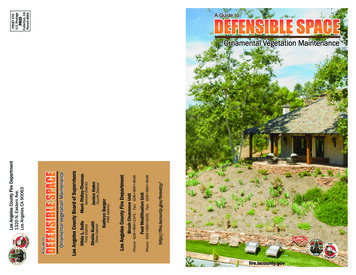
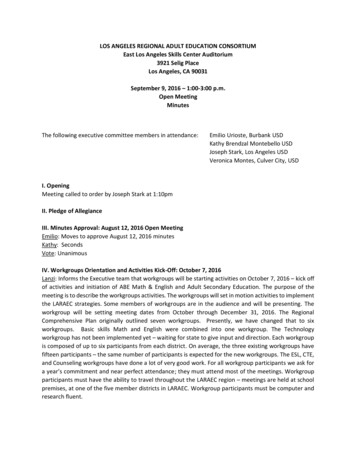

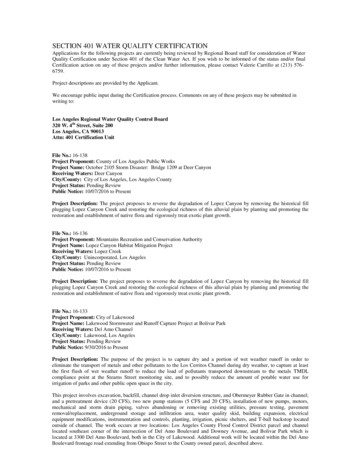
![bTBiesaFn Ep k BIsðèl EdleyIgsmnwgTTYl - calfund [.] org](/img/39/preschool-toolkit-cambodian.jpg)
